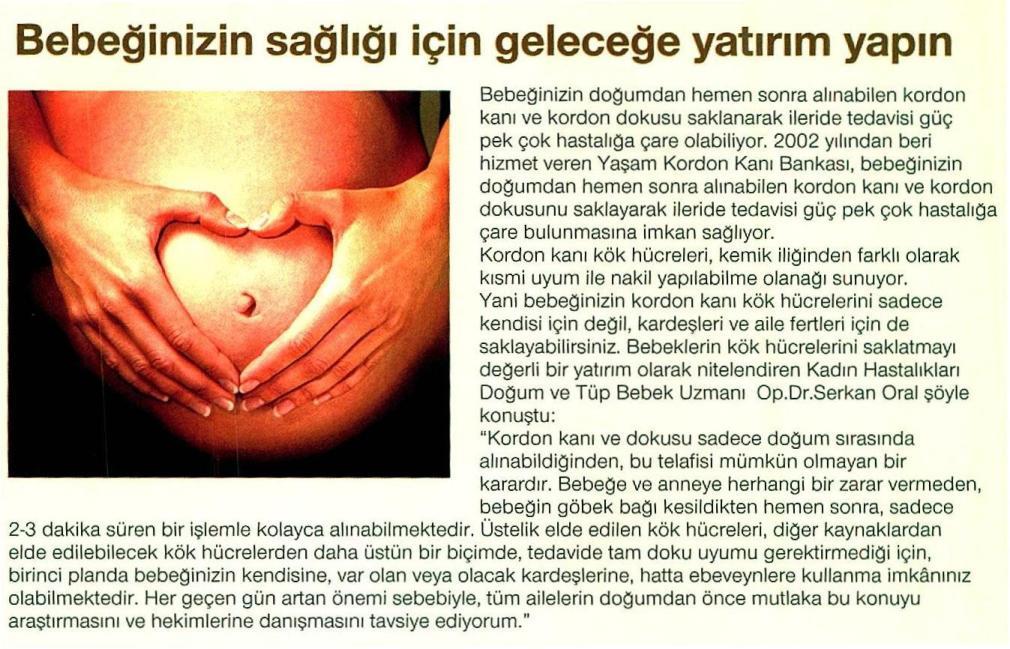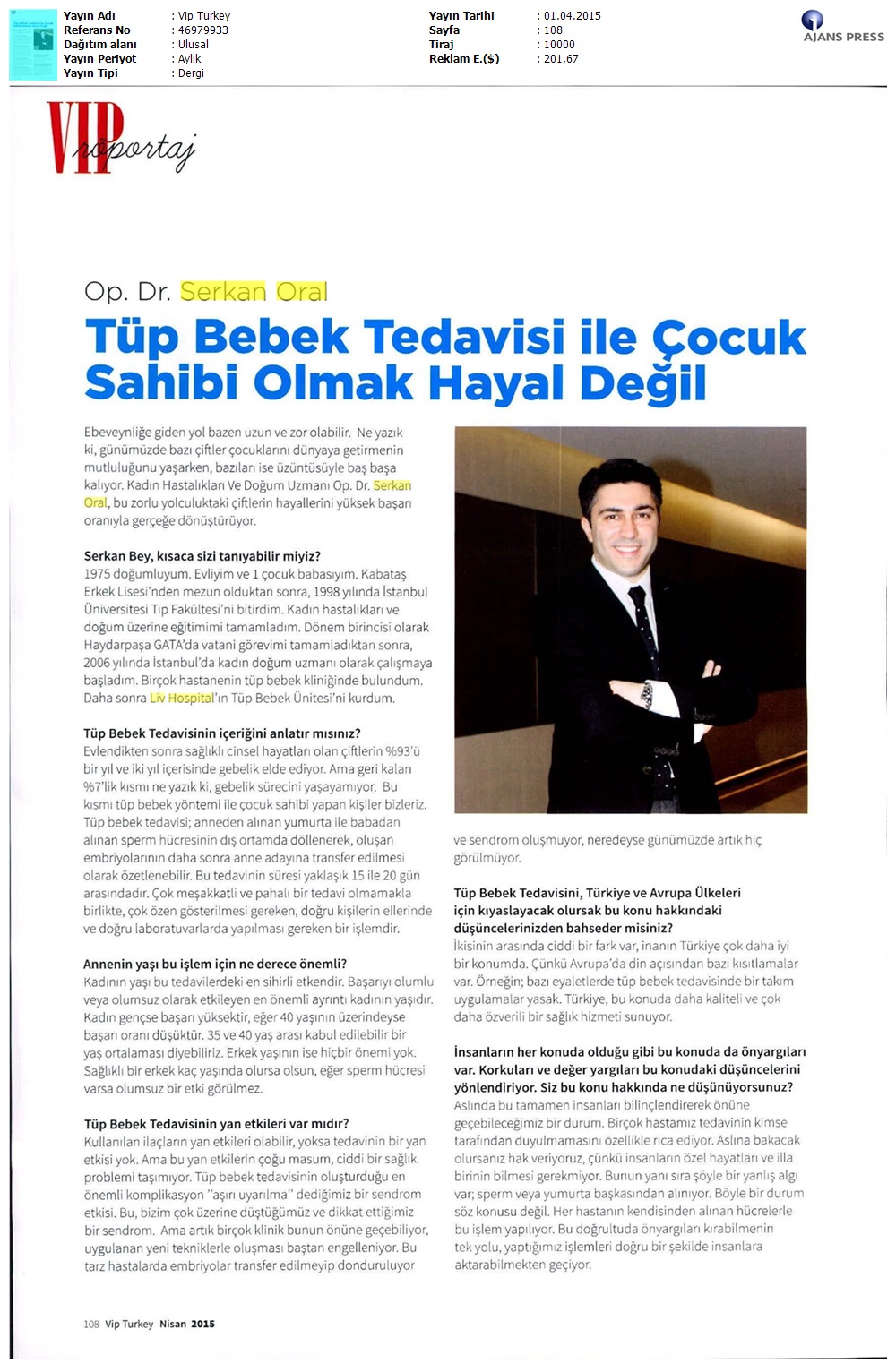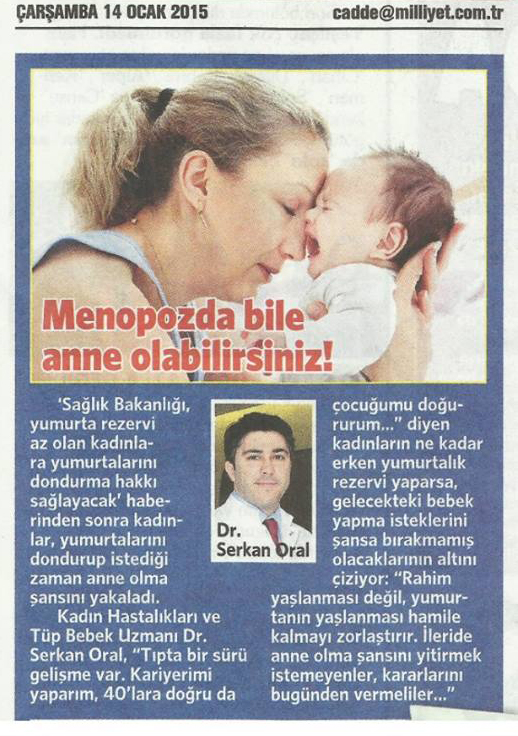In the Press

Sağlıkta Kötü Haberlere Yolun Başında Önlem Alın!
Kadın Hastalıkları Doğum ve Tüp Bebek Uzmanı Doç. Dr. Serkan Oral, bebeğinizin kök hücrelerini saklatmayı değerli bir yatırım olarak nitelendirdi.
Capital Brave / Mart 2016
Kaynak: http://www.capitalbrave.com.tr/saglikta-kotu-haberlere-yolun-basinda-onlem-alin/
Emzirme Gebelikten Korur mu?
Kadın Hastalıkları Doğum ve Tüp Bebek Uzmanı Doç. Dr. Serkan Oral, emzirme döneminde vücutta meydana gelen değişikliklerin gebelik riskinden yüksek oranda koruyabileceğini ifade etti ve “ekolojik emzirme yöntemi” ile gebelikten korunmak için gereken kriterleri açıkladı.
Anne Bebek Çocuk Dergisi / Mart 2016
Bebeğinizin Sağlığı için Geleceğe Yatırım Yapın
Bebeğinizin doğumdan hemen sonra alınabilen kordon kanı ve kordon dokusu saklanarak ileride tedavisi güç pek çok hastalığa çare olabiliyor.
Baby & You Dergisi / Mart 2016
Hamile Kalmayı Kolaylaştıran 10 Öneri
Hamile kalmak için en uygun dönem hangisi, korunmayı bıraktıktan ne kadar süre sonra hamile kalınabilir ve daha kolay hamile kalmak için neler yapılabilir? İşte, cevaplar…
Posta Gazetesi / Mart 2016
Hamilelikte Seyahatin Püf Noktaları
Hamilelikte seyahat ederken gidilecek yerin iklim ve hijyen koşullarını bilmek, yolun uzunluğunu düşünmek ve seyahat sırasında hangi aracın kullanılacağını belirlemek gerekiyor.
Sabah Gazetesi / Şubat 2016
Tüp Bebekte Doğru Bilinen 10 Yanlış
Toplumda Tüp Bebek Tedavisi ile ilgili bilgi kirliliği olduğunu söyleyen Kadın Hastalıkları Doğum ve Tüp Bebek Uzmanı Doç. Dr. Serkan Oral, doğru bilinen yanlışları sıraladı.
Milliyet Gazetesi / Şubat 2016
Hamileyseniz Bilinçsiz Spordan Kaçının
Hamilelikte egzersiz yararlıdır ancak bilinçsiz yapılan egzersiz hareketleri, özellikle hamileliğin ilk birkaç ayında düşükle karşılaşılmasına sebep olabilir.
Sabah Gazetesi / Ocak 2016
Tüp Bebek Tedavisi ile Çocuk Sahibi Olmak Hayal Değil
Kadın Hastalıkları Doğum ve Tüp Bebek Uzmanı Doç. Dr. Serkan Oral, tüp bebek tedavisinin ilgili detaylarını ve Türkiye’deki tedavi koşullarını anlattı.
VIP Türkiye Dergisi / Nisan 2015
Adı Masum Kendisi Değil Çikolata Kisti
Kadın Hastalıkları Doğum ve Tüp Bebek Uzmanı Doç. Dr. Serkan Oral, bilinen ve bilinmeyen yanlarıyla çikolata kistini anlattı.
Günaydın Gazetesi / Ağustos 2015
Derya’nın Dünyası - Kanaltürk
Kadın Hastalıkları Doğum ve Tüp Bebek Uzmanı Doç. Dr. Serkan Oral – Derya’nın Dünyası (Kanaltürk)
Doç. Dr. Serkan Oral, Evde Doğum Hakkında Bilgiler Verdi
Ünlü oyuncu Özgü Namal, geçtiğimiz günlerde oğlu Nefes’i evinde doğum yaparak kucağına aldı. Videoda Kadın Hastalıkları Doğum ve Tüp Bebek Uzmanı Doç. Dr. Serkan Oral’ın açıklamalarına yer veriliyor.
Dilara Koçak ile İyi Yaşam - Kanaltürk
Kadın Hastalıkları Doğum ve Tüp Bebek Uzmanı Doç. Dr. Serkan Oral – Dilara Koçak’la İyi Yaşam (Kanaltürk)
Ece Erken, Bebeği Eymen’i Kucağına Aldı!
Ece Erken ve Serkan Uçar çifti, 7 Nisan 2015 günü sabah saatlerinde Liv Hospital’da ufak Eymen’e kavuştular. Doğumunda ve hamilelik sürecinde yanlarında olan Doç. Dr. Serkan Oral, Facebook sayfasında duygularını şöyle paylaştı:
“Sevgili Ece Erken bugün oğlu Eymen’i kollarına aldı. İkisininde sağlık durumu çok iyi. 9 ay boyunca hep yanlarındaydım ve sonunda onlarla beraber bu mutluluğu yaşadığım için çok gururluyum.”
Bu mutlu haberi Instagram hesabından paylaşan Serkan Uçar ise şöyle yazdı:
“Oğlum Eymen 15 dakika önce dünyaya geldi. Allah’ım sana binlerce kez şükürler olsun. Bugün hayatımın en mutlu günü. Yaklaşık 3500 gram olarak dünyaya gelen Eymen’in boyuysa 55 cm.”
Ece Erken’in doğum haberini aşağıdaki diğer basın bültenlerinden bulabilirsiniz:
Burak – İstem Yılmaz Çifti “Nazlı”larına Kavuştu!
Burak Yılmaz, İstem Yılmaz çifti geçtiğimiz hafta Liv Hospital’da, kızları Nazlı’yı kucaklarına aldılar. Doğumu gerçekleştiren Doç. Dr. Serkan Oral, Facebook sayfasında Burak Yılmaz’la çekildiği fotoğrafı şu yorumla paylaştı:
Sevgili kardeşim Burak Yılmaz, kızı Nazlı’nın doğumunda yardımcı olmak için önlüğü giyip yanıma geldi. Nazlı’nın anne babasına ve bütün insanlığa hayırlı bir evlat olması dileğimle
Bu haberi, aşağıdaki diğer basın web sitelerinde de bulabilirsiniz:
Menopozda Bile Anne Olabilirsiniz!
Kadın Hastalıkları Doğum ve Tüp Bebek Uzmanı Doç. Dr. Serkan Oral, genç yaşta yumurta dondurmayla menopozda anne olunabileceğini anlattı.
Makaron Gazetesi
İstediğin Yaşta Anne Ol!
Kadın Hastalıkları Doğum ve Tüp Bebek Uzmanı Doç. Dr. Serkan Oral, genç yaşta yumurta dondurmayla menopozda anne olunabileceğini anlattı.
Not: Basın mecrası ve tarihiyle ilgili bilgi yok
Menopozda Bile Anne Olabilirsiniz!
Kadın Hastalıkları Doğum ve Tüp Bebek Uzmanı Doç. Dr. Serkan Oral, genç yaşta yumurta dondurmayla menopozda anne olunabileceğini anlattı.
Milliyet Gazetesi / Ocak 2015
Menopoza Girseniz Bile Anne Olabilirsiniz!
Kadın Hastalıkları Doğum ve Tüp Bebek Uzmanı Doç. Dr. Serkan Oral, genç yaşta yumurta dondurmayla menopozda anne olunabileceğini anlattı.
Not: Basın mecrası ve tarihiyle ilgili bilgi yok
Çoğul Gebeliklerde Annelerin Yaşadığı Sıkıntılar
Hamilelik, anne için oldukça heyacan verici, keyifli bir süreç olmasının yanı sıra kimi sıkıntıları da içinde barındırır. Üstelik çoğul gebelikte sıkıntılar bir kat daha artabilir. Kadın Hastalıkları Doğum ve Tüp Bebek Uzmanı Doç. Dr. Serkan Oral, çoğul gebelikte annelerin ne türlü sorunlarla karşılaştığını anlattı.
Baby & You Dergisi / Aralık 2014
Doğurganlık Problemleri Çözümsüz Değil
Çocuk sahibi olmak istiyor ancak bir türlü hamile kalamıyor olabilirsiniz. Günümüzde ne yazık ki pek çok kadın bu durumdan şikayetçi. Doğurganlığın önündeki engelleri ve neler yapılabileceğini Kadın Hastalıkları ve Doğum Uzmanı Doç. Dr. Serkan Oral açıklıyor.
Cosmopolitan Dergisi / Ekim 2014
Başarısız Tüp Bebekte ERA testi umudu!
Kadın Hastalıkları Doğum ve Tüp Bebek Uzmanı Doç. Dr. Serkan Oral, bebek sahibi olmak isteyen ailelerin ERA testi sayesinde tüp bebek tedavisinde başarı oranının yüzde 80 arttığını anlattı.
Akşam Gazetesi / Ağustos 2014
Enfeksiyon Tedavisi Hemen Yapılmalı
Kadın Hastalıkları Doğum ve Tüp Bebek Uzmanı Doç. Dr. Serkan Oral, kadınların deniz ve havuzdan sonra ıslak mayoyla kalmasının idrar yolu enfeksiyonuna neden olduğunu söyleyerek ekledi: “Bu enfeksiyonların tedavisi hemen yapılmalıdır.”
Sabah Gazetesi / Ağustos 2014
Hamilelikte Denize Girmek Sakıncalı mı?
Yüzmenin hem dolaşım sistemi hem de kaslar üzerinde olumlu etkileri olduğundan yaz aylarında hamilelerin yapabilecekleri en yaygın sporların başında geliyor. Fakat deniz veya havuza girerken annne adaylarının bazı konulara dikkat etmeleri gerekiyor. Kadın Hastalıkları Doğum ve Tüp Bebek Uzmanı Doç. Dr. Serkan Oral anne adaylarını bilgilendiriyor.
Annelik Sanatı Dergisi / Ağustos 2014
Her Yanım Ağrıyor!
Hamilelik sürecinizle birlikte artan kilo, bacaklara binen yük ve sızlanan siz… Karın ağrılarınız, vücudun halimeliğe alşıma sürecinden kaynaklandığından endişe duymamalısınız. Yüne aynı şekilde göğüslerinizde şişme ve ağrılar olabilir. Kadın Hastalıkları Doğum ve Tüp Bebek Uzmanı Doç. Dr. Serkan Oral, hamilelik ağrıları hakkında sorularınızı yanıtladı.
Anne Bebek Dergisi / Temmuz 2014
"Tam İsabet!" Tüp Bebek Lightbox
Kişiye özel tüp bebek yöntemleri için hekiminize baş vurun.
Make the bulsseye hit at Liv Hospital IVF Clinic
Hamileyken iki kişilik yediğinizi unutmayın!
Bebek Bekleyen kadınların en büyük endişelerinde biri de bebekleri için yeterli beslenip beslenmedikleridir. Kadın Hastalıkları Doğum ve Tüp Bebek Uzmanı Doç. Dr. Serkan Oral, hamilelikte daha sağlıklı beslenmenin yollarını anlattı.
Sabah Gazetesi / Mart 2014
Günlük 80 Gram Protein Alın
Hamile olduğunu yeni öğrenen anne adaylarının büyük çoğunluğu için en dikkat çeken konulardan biri de beslemenin nasıl olması gerektiğidir. Kadın Hastalıkları ve Doğum Uzmanı Doç. Dr. Serkan Oral, hamilelik sürecinde protein alımınıyla ilgili bilgiler verdi.
Anne Bebek Dergisi / Nisan 2014
Sigara tüp bebeği olumsuz etkiliyor!
Sigara kullanan kadınlarda tüp bebek tedavisi sürecinde daha yüksek doz hormon tedavisine gerek duyuluyor; çünkü sigara sigara kullana kadınlarda kan ve östrojen seviyesi diğer kadınlara göre daha düşük olduğu için daha az miktarda yumurta gözleniyor. Kadın Hastalıkları Doğum ve Tüp Bebek Uzmanı Doç. Dr. Serkan Oral, sigara içmenin tüp bebek tevavisindeki olumsuz etkilerini anlattı.
Posta Gazetesi / Şubat 2014
Eski Hatalarım Bebeğimi Nasıl Etkileyecek?
Hamile kalmadan önce yaptığımız bazı hataları davranışlar, kötü alışkanlıklar acana doğacak bebeğinizin sağlığını etkiler mi? Anne adaylarının merak ettiği bu soruların cevabını Kadın Hastalıkları ve Doğum Uzmanı Doç. Dr. Serkan Oral cevapladı.
E-Bebek Dergisi / Ocak 2014



























